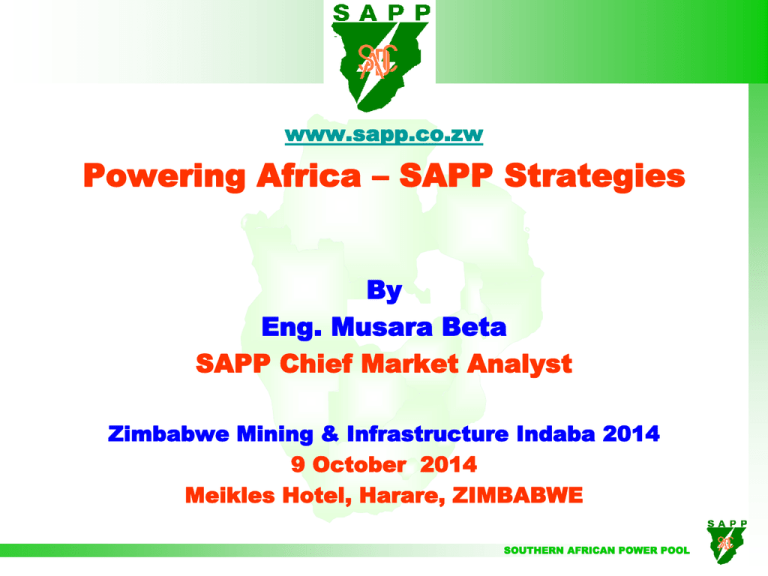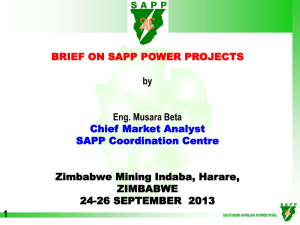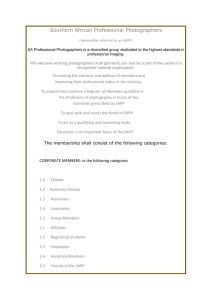Beta Powering Africa _SAPP Generation Strategies_Zimbabwe
advertisement

www.sapp.co.zw Powering Africa – SAPP Strategies By Eng. Musara Beta SAPP Chief Market Analyst Zimbabwe Mining & Infrastructure Indaba 2014 9 October 2014 Meikles Hotel, Harare, ZIMBABWE SOUTHERN AFRICAN POWER POOL CONTENTS 1. INTRODUCTION TO THE SAPP 2. POWER SUPPLY CHALLENGES IN THE SAPP 3. SAPP STRATEGIES TO MEET DEMAND 4. SAPP COMPETITIVE MARKET 5. CONCLUSIONS SOUTHERN AFRICAN POWER POOL 1. INTRODUCTION TO THE SAPP 1.1 Key Facts 12 Countries 280 Million people Installed Generation Capacity - 58 GW Available Generation Capacity - 51 GW Peak Demand - 54 GW Consumption - 400TWh DR Congo Tanzania Angola Malawi Zambia Zimbabwe Namibia Botswana Mozambique Swaziland South Africa Lesotho SOUTHERN AFRICAN POWER POOL 1.2 SAPP Membership No Full Name of National Power Utility Status Abbreviation Country 1 Botswana Power Corporation OP BPC Botswana 2 Electricidade de Mocambique OP EDM Mozambique 3 Electricity Supply Corporation of Malawi NP ESCOM Malawi 4 Empresa Nacional de Electricidade NP ENE Angola 5 ESKOM OP Eskom South Africa 6 Lesotho Electricity Corporation OP LEC Lesotho 7 NAMPOWER OP Nam Power Namibia 8 Societe Nationale d’Electricite OP SNEL DRC 9 Swaziland Electricity Board OP SEB Swaziland 10 Tanzania Electricity Supply Company Ltd NP TANESCO Tanzania 11 12 No 13 14 15 16 ZESCO Limited OP ZESCO Zambia Zimbabwe Electricity Supply Authority OP ZESA Zimbabwe Full Name of Private Utility Copperbelt Energy Corporation Lunsemfwa Hydro Power Company Hidro Cahora Bassa Mozambique Transmission Compamy Status ITC IPP OB OB Abbreviation CEC LHPC HCB MOTRACO Country Zambia Zambia Mozambique Mozambique OP: Operating OB: Observer NP: Non-Operating ITC: Independent Transmission Company SOUTHERN AFRICAN POWER POOL IPP: Independent Power Producer 2. POWER SUPPLY CHALLENGES IN SAPP No Country Utility Installed Capacity [MW] As at Aug 2014 1 Angola ENE 2,195 2 Botswana BPC 892 3 DRC SNEL 2,442 4 Lesotho LEC 5 Malawi 6 Available Capacity [MW] Aug 2014 Forecast/ Peak Demand Capacity Shortfall including reserves, MW Calculated Reserve Margin, % 1,772 1599 680 610 1,251 1342 72 72 138 ESCOM 351 351 326 Mozambique EDM /HCB 2308 2,279 850 7 Namibia NamPower 501 392 635 8 South Africa Eskom 44,158 41,074 37661 9 Swaziland SEC 70 70 219 10 Tanzania TANESCO 1396 1,159 905 11 Zambia ZESCO / CEC/LHPC 2,128 2,029 2287 12 Zimbabwe ZESA 2,045 1,540 1961 58,558 52,669 48,533 (2,758) 7.9% 54,616 49,387 45,703 (1,253) 7.5% TOTAL SAPP Total Interconnected SAPP As at Aug 2014, total SAPP installed capacity was 58.6 GW SOUTHERN AFRICAN POWER POOL 2. POWER SUPPLY CHALLENGES IN SAPP Demand for power in Southern African has been increasing at an average rate of 3% per annum. In 2007, demand growth for South Africa was 4.9% and for the whole region 4.6%. In the last 10 years demand in the SAPP increased by more than 32% which is equivalent to 13,000 MW (from 41,000 MW in 2004 to 54,000MW in 2013). Unfortunately, there has been no corresponding investments in generation and transmission infrastructure, (11,469MW generation added from 2004 to 2013) resulting in the current supply deficit that the region is experiencing. SOUTHERN AFRICAN POWER POOL Why has the SAPP run into supply deficit ? 1. Economic Growth of more than 5% in most of the SADC member countries resulting in unprecedented growth in electricity consumption and demand. 2. Increase in demand for base metals resulting in high metal prices on the World Market with new mining companies being established in the SADC region in the last few years. 3. Inadequate Investments in generation and transmission infrastructure over the last 20-years. 4. Electrification Programmes have partly contributed to the increased consumption and demand. 5. The challenge was identified and communicated but not adequately mitigated. SOUTHERN AFRICAN POWER POOL 3. SAPP STRATEGIES TO MEET DEMAND The SAPP has proposed the following measures: 1. Demand Management based on others experiences: Power Conservation Programme (PCP) Study and understand the concept of PCP Formulate and adopt PCP for SADC Demand Side Management (DSM) Mechanism to provide financial support for development and implementation of DSM in the SADC Develop local manufacturing capability to support DSM initiatives. SADC Policy for efficient use of electrical energy • Incandescent versus CFLs • Minimum energy efficiency standards for new connections SOUTHERN AFRICAN POWER POOL DSM- SAPP VIRTUAL POWER STATION – WHERE IS THE SAPP? Demand Reduction (MW) CFL SWH Commercial Lighting HWLC 7000 6000 5000 4000 3000 2000 1000 0 2012 2013 2014 2015 2016 2017 2018 4,500 MW saving and Virtual Power Station established SOUTHERN AFRICAN POWER POOL Impact of DSM On Load Management[2009 – 2015] All SAPP Members Capacity Required Peak Demand If no load management options implemented, the deficit could have been worse 2009 Plan 2015 2014 2013 2012 2011 2010 2009 MW 90000 85000 80000 75000 70000 65000 60000 55000 50000 45000 40000 Year Capacity Planned Peak Demand after load reduction Situation improves and is better after load management. 2015 2014 2013 2012 2011 2010 85000 80000 75000 70000 65000 60000 55000 50000 45000 40000 35000 30000 2009 MW Capacity Required Year SOUTHERN AFRICAN POWER POOL Creating an Enabling Environment 2. 3. Create an enabling environment for power sector investment: Policy and Legal framework Regulatory framework SAPP Governance documents revised from 2006 to accommodate other players such as IPPs, Large Users etc in the structures of SAPP Implement cost reflective and time of use tariffs in SADC member countries. SOUTHERN AFRICAN POWER POOL Supply Side Measures 4. Supply Side Measures Maximize utilization of all installed supply option Re-capitalization of power utilities Short and Medium-term generation projects Ensure projects are properly prepared for financing Governments to prioritize funding of power projects Create an enabling environment for renewable energy Develop a structure for the implementation of a least-cost SAPP generating facility 5. Provide Investment incentives to all Investors in the power sector, both local and foreign. Address policy issues relating to legal & regulatory frameworks, i.e. enabling environment. Allow for VAT and tax exemptions for import of power equipment and machinery for a defined period. SOUTHERN AFRICAN POWER POOL Commissioned Generation Capacity Planned Generation Capacity versus Actual Commissioned for period 2004-2013 Planned Gen. Capacity Actual Commissioned Difference: Planned minus Year (MW) Capacity (MW) Commissioned (MW) 4,000 Planned Gen. Capacity (MW) 3,500 Actual Commissioned Capacity (MW) 3,000 2004 2005 2006 2007 2008 2009 2010 2011 2012 2013 Total 260 520 1,041 2,441 2,014 2,400 908 1,751 3,552 1,992 16,879 320 490 375 1,696 1,747 2,187 848 1,230 1,099 1,477 11,469 60 (30) (666) (745) (267) (213) (60) (521) (2,453) (515) (5,410) 2,500 2,000 1,500 1,000 500 2004 2005 2006 2007 2008 2009 2010 2011 2012 2013 SOUTHERN AFRICAN POWER POOL Generation Projects Planned for 2014 - 2018 No Country COMMITTED GENERATION CAPACITY, MW 2014 150 2015 0 2016 1280 2017 2271 1 Angola 2 Botswana - - - 3 DRC - 430 4 Lesotho - 5 Malawi 6 Mozambique 7 Namibia 8 RSA 9 2018 TOTAL 0 3,701 - 600 600 150 240 1,620 2,440 - 35 - - 35 - - - - 74 74 175 - 40 - 600 815 - - 15 - 1,050 1,065 2,376 2,811 3,464 1,918 2,866 13,435 Swaziland - - - - - 10 Tanzania - 150 500 460 700 1,810 11 Zambia 195 435 15 426 - 1,071 12 Zimbabwe - 15 - 420 2,400 2,835 2,896 3,841 5,499 5,735 9,910 27,881 TOTAL - SOUTHERN AFRICAN POWER POOL Demand and Supply Situation 2013-2018 90000 80000 70000 60000 50000 40000 30000 20000 10000 0 2013 2014 2015 Peak Demand 2016 2017 2018 Capacity Planned Planned Capacity will exceed peak demand by 2016. SOUTHERN AFRICAN POWER POOL Transmission Integration Projects 2015 -2018: ZIZABONA -220/330 kV DRC 2018: Mozambique Malawi Tanzania 2018: Zambia - Tanzania - 400 kV Malawi Angola Zambia 2018:DRC - Angola – 400 kV Zimbabwe 2020: MOZAMBIQUE BACKBONE -RSA 2015-2025: 765 kV Strengthening Namibia Mozambique Botswana Swaziland 2017: RSA Strengthening South Africa Lesotho 2018: Botswana Strengthening SOUTHERN AFRICAN POWER POOL 4. SAPP COMPETITIVE MARKET SAPP Developed and started operating the Day Ahead Market (DAM) IN December 2009 SAPP is currently developing following markets for operation mid 2015 a) Month Ahead Market (MAM) Trading will be done for a month ahead (for delivery in the next month) b) Week Ahead Market (WAM) Trading will be done a week ahead (for delivery the following week) c) Intra Day Market (IDM) Trading will be done an hour ahead (for delivery in the next hour in a day) SOUTHERN AFRICAN POWER POOL Trading in the various timeframes after NTP MW IDM trading DAM TRADING Weekly forward trading Monthly Forward trading Bilateral contracts Own production 24 hours SOUTHERN AFRICAN POWER POOL Market Performance Highlights – Market Share 350000 DAM & PDAM Trades (MWhr) 300000 Non Investment Bilateral Trades (MWhr) 250000 200000 150000 100000 50000 0 Feb-14 Mar-14 Apr-14 May-14 Jun-14 Jul-14 Aug-14 Average Competitive Market share was almost 16% Market share increased significantly from April 2014 through to August 2014. SOUTHERN AFRICAN POWER POOL 5. CONCLUSIONS Projects Packaging is critical for projects to attract funding and be implemented SAPP CC plays a critical role in mobilising grant funding and project coordination A Master Plan for the regional power market is vital as it: Helps to reduce capital costs by implementing leastcost projects for the benefit of the region. Reduces excess capacity from the pool. In the SAPP, SAPP Pool Plan noted that a saving of over US$48 billion could be realized if projects are implemented in a coordinated fashion. SOUTHERN AFRICAN POWER POOL Thank you for your attention SOUTHERN AFRICAN POWER POOL










